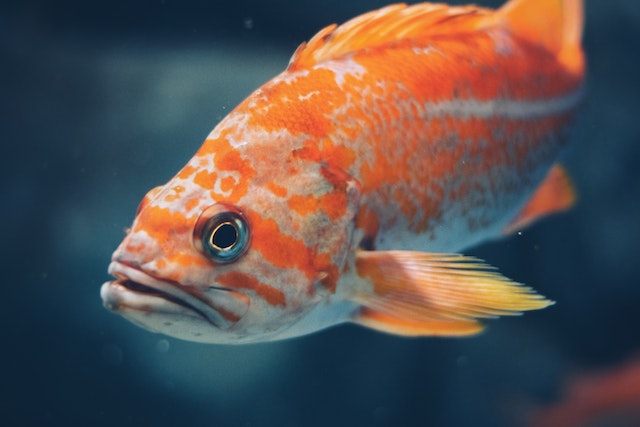
How do fish breathe underwater? Fish use their gills to take oxygen out of the water.
Why do we need oxygen? Most living beings need oxygen to create energy. All animals need to respire, which is the process of releasing energy by breaking down glucose. There are two ways to respire: aerobic and anaerobic. Aerobic respiration uses oxygen and anaerobic respiration doesn’t.
Some bacteria and fungi respire anaerobically. They tend to live in environments without oxygen and they have evolved to break down glucose in a different way. They can use sulfur or nitrate to break down the glucose. We can actually make energy through anaerobic respiration. Our muscles need energy, which is created from a store of glucose and a constant supply of oxygen. However, it takes a few seconds before this system can be kick started. Before it is up and running, our muscles make energy from the glucose stores they have without using oxygen. Because there is no oxygen, the glucose isn’t broken down so efficiently and lactic acid is created, which needs to be oxidized.
Most animals use aerobic respiration to make energy. Oxygen in the blood reacts with glucose, producing adenosine triphosphate (ATP), carbon dioxide, and water. The cells can use ATP as energy. The carbon dioxide is expelled, and the water is absorbed. Oxygen is highly corrosive, and some people say that this process is one of the reasons why we age.
The majority of organisms that respire anaerobically get their oxygen from the air. The air we breathe is 21 percent oxygen, 78 percent nitrogen, and a little bit of carbon dioxide, neon, and hydrogen. We use the oxygen to create ATP, but we cannot use the nitrogen. It is non-reactive and has no use, so we just breathe it back out in exactly the same quantity as we breathe it in. We have evolved to respire with 21% oxygen. If that amount goes down, on top of Mt. Everest, for example, our cells cannot make energy and have to shift to partial anaerobic respiration. This causes the build up of lactic acid and a lot of other symptoms that are the signs of hypoxia. Above 21% can also cause damage to the organs.
Fish gills are exposed directly to water in order for them to breathe. As humans, we obviously cannot breathe underwater. We need to keep our lungs free of fluid. We breathe in air through our noses and the air goes down our windpipes and into our lungs. Each lung has about 300 million small balloons called alveoli and these expand when the air flows into them. Oxygen crosses through the walls of these balloons and is carried away by small blood vessels. Carbon dioxide flows the other way, out of the blood and into the balloons. Then we breathe out, the balloons deflate, and we expel carbon dioxide from our bodies.
So, what do fish do? How do they breathe when they are surrounded by water? Well, they breathe in a very similar way, except without the air. Water carries a lot of dissolved oxygen, although the concentration changes with the quality of the water and the
. Oxygen is absorbed from the atmosphere and held in the ocean. The percentage increases under the surface because cold water can hold more oxygen and there are fewer fish to use it. However, past about 1000m, it starts to decline again.
In our lungs, the oxygen-rich air is exposed to the blood vessels, and the same is true of fish. Fish take in water through their mouths. This water then flows out of the fish through its gills. In the gills are many small filaments with blood vessels very close to the surface. These blood vessels absorb the oxygen out of the water. The more filaments and the more blood vessels the fish has, the easier it is to breathe because the larger surface area gives more opportunity for oxygen to pass into the blood. As the oxygen goes in, the carbon dioxide goes out, in the same way as with mammals. It is a lot harder for fish to get oxygen out of the water than it is for us to get it out of the air because air has 200,000 parts per million whereas water only has about 8 parts per million. To cope with this, fish constantly run water over their gills and their gills are a lot more efficient than our lungs are. They also use far less energy than we do because they are cold blooded, so they don’t need as much oxygen. This is why warm-blooded ocean dwellers like whales have to breathe air.
When we take fish out of the water, they cannot breathe because there is no water carrying oxygen over their gills. Likewise, we wouldn’t be able to breathe underwater because our lungs don’t have the surface area to pull the oxygen out of the water and, even if it did, the oxygen content of water is so low that we would not be able to breathe enough of it. And this is what I learned today.
Sources
https://www.bbc.co.uk/bitesize/guides/zsry39q/revision/2
https://byjus.com/biology/aerobic-anaerobic-respiration/
https://www.goodrx.com/conditions/anesthesia/oxygen-toxicity
https://en.wikipedia.org/wiki/Hypoxia_(medical)

Pingback: Why do fish have scales? - I Learned This Today